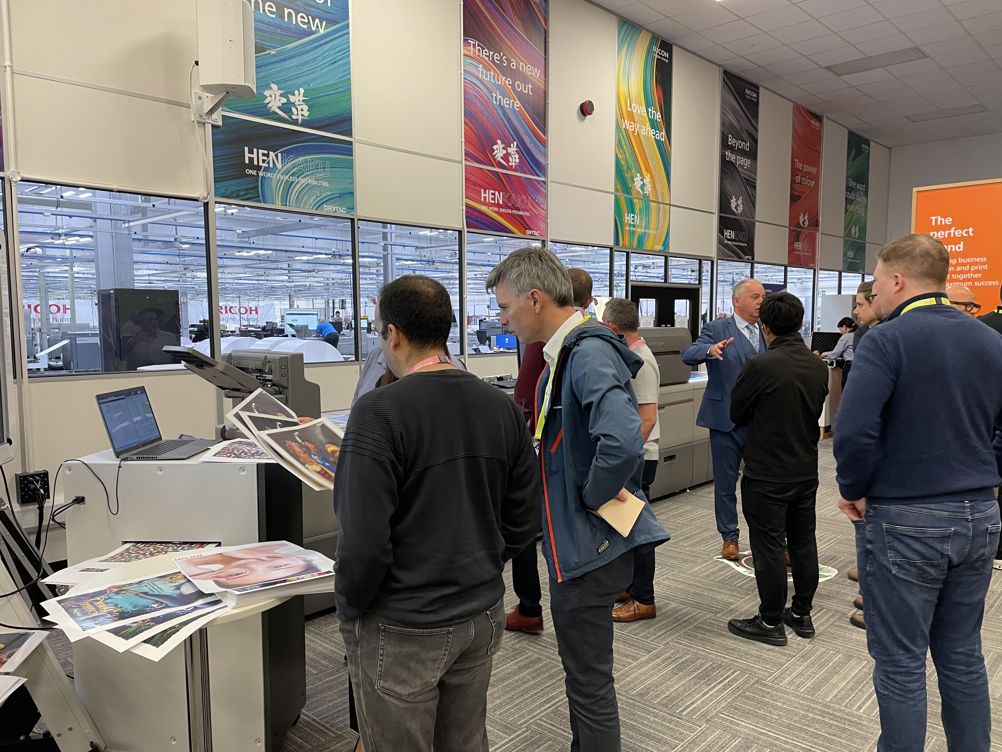Speaking to Printweek at this week’s Print Evolution Live event at Ricoh’s Customer Experience Centre in Telford, Tim Carter, commercial print director at Ricoh Graphic Communications revealed more details on the Pro Z75 duplexing press in terms of technology and customers.
The press, which has been under development for around five years, has a top speed of 4,500iph (4,500sph single sided, 2,250 duplex) and runs water-based inks.
While the development programme was impacted by Covid, in terms of supply chain challenges around certain components, Carter said “since then we have really ramped and scaled up development”.
This has included the successful completion of a beta programme at US printer Heeter, with a number of UK early adopter prospects visiting the installation. According to Carter, the beta has now been signed off and it’s in full operation running double day shifts.
“So, we’re now moving into the launch programme,” he said.
While he qualified it as a “gentle launch”, the first European installation is already underway at an online printer in France.
Once that is complete, the next installation will be at a gifting printer in The Netherlands.
“We expect the third installation to be in January at a UK print operation,” said Carter. “There will be four units installed in Europe by the end of our financial year, which is next March.
“From then we will be scaling up. Scaling up manufacturing in Japan, support resource in each of the countries and geographies and that will start in earnest, and quite aggressively, from April next year.”
He added that Drupa in May 2024 would be “an opportunity for us to showcase technology that does what it says on the tin”.
While he wouldn’t be drawn on the identity of the UK customer, he said that it was a commercial printer.
“We’ve a huge amount of interest, and we have to manage that interest and prioritise… I would expect our main focus for early [UK] installations will be into commercial offset environments.
“In the main, the major interest [so far] has been in offset migration, with no compromise in terms of media choice and image quality.
“The ROIs that are associated with the technology and the significant reduction in the cost per page means the breakeven point between toner and now inkjet has increased quite significantly.”
The Pro Z75 uses adapted Ricoh Gen 5 heads housed in a water-cooled environment, runs Ricoh water-based inks and the delivery system and electronics are also Ricoh technology – the DFE has been jointly developed with Fiery.
“The product, in its standard configuration has been innovated, developed and engineered entirely by Ricoh,” Carter stated.
It has inherited a variant of the ‘swing and shift’ registration system from Ricoh’s toner engines and, according to Carter, the feedback on the water-cooled 1,200dpi head set-up has been overwhelmingly positive in terms of its impact on reducing “very significantly” jet outs and nozzle failures compared to standard systems.
Like the VC70000 high-speed inkjet press, the Z75 it can print directly onto standard offset coated media, with Carter adding it can also run, and has been tested on, a wide range of uncoated and glossy media – but it can also be configured with an optional under coater.
He said it was an option simply because using an undercoat on non-pre-coated, uncoated media gives a “pop and lift” that matches litho.
“But it [the under coater] won’t be mandatory as there will be a huge variety of opportunities to jet onto a standard offset sheet.”
The first installations will be able to handle media down to 100gsm – this will go down to 60gsm for Drupa – and can handle boards up to 600mic, to open up packaging applications.
With that in mind, while the first machines are CMYK, there is space above the drum to add fifth and six colours in later incarnations.
Simon Isaacs, national director at Ricoh UK Graphic Communications Group, said while the Z75 technology at its heart was scalable, he wasn’t aware of a roadmap to scale to B1 as this would require a “complete platform redesign” and the business believed the B2 market was the best place to target.
Issacs said that one of the biggest challenges with introducing any game-changing digital print technology was the print business’s workflow and this would be a focus for Ricoh, to ensure customers could maximise the opportunity afforded by the Pro Z75.
“It’s incumbent upon us to ensure we can help customers as part of a long-term partnership programme to understand how they derive more value from our technology,” added Carter, citing Ricoh’s Edge programme as an example.
Isaacs and Carter were speaking at Ricoh’s Print Evolution Live event, which ran across Tuesday, Wednesday and Thursday this week and welcomed more than 100 customers and prospects across the first two days.

As well as “on request” virtual demonstrations of the Z75, the event featured product demos, panel discussions and presentations. Day one was for commercial clients, day two for inplants and corporate, and day three was a dedicated reseller day.
The event was the launchpad for the recently unveiled Pro C9500 and Pro C7500 ranges as well as the new Ricoh Auto Color Adjuster.










